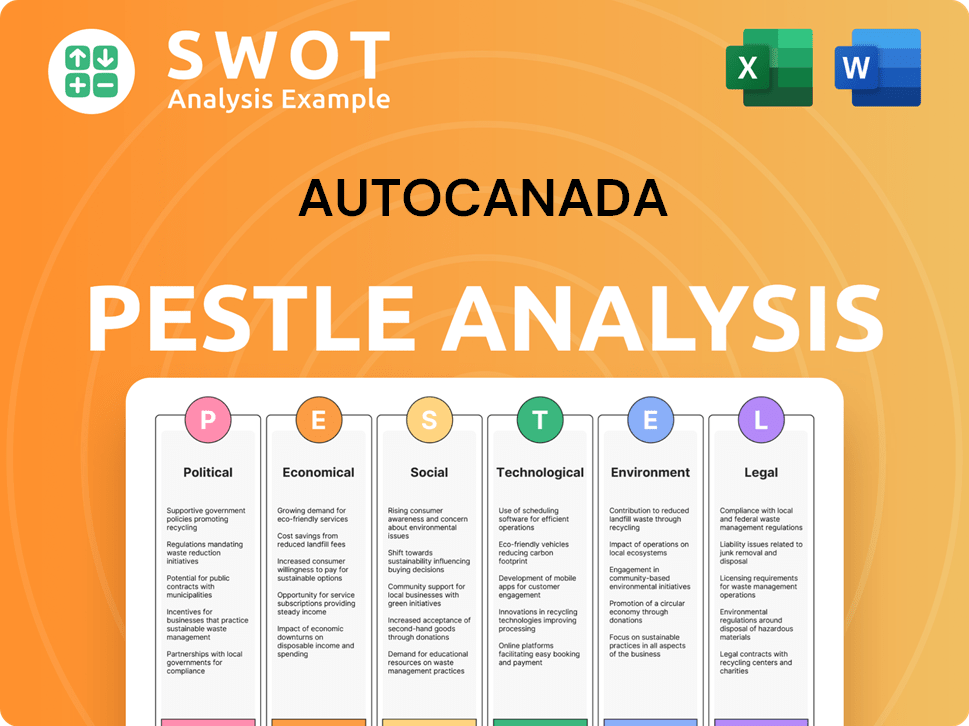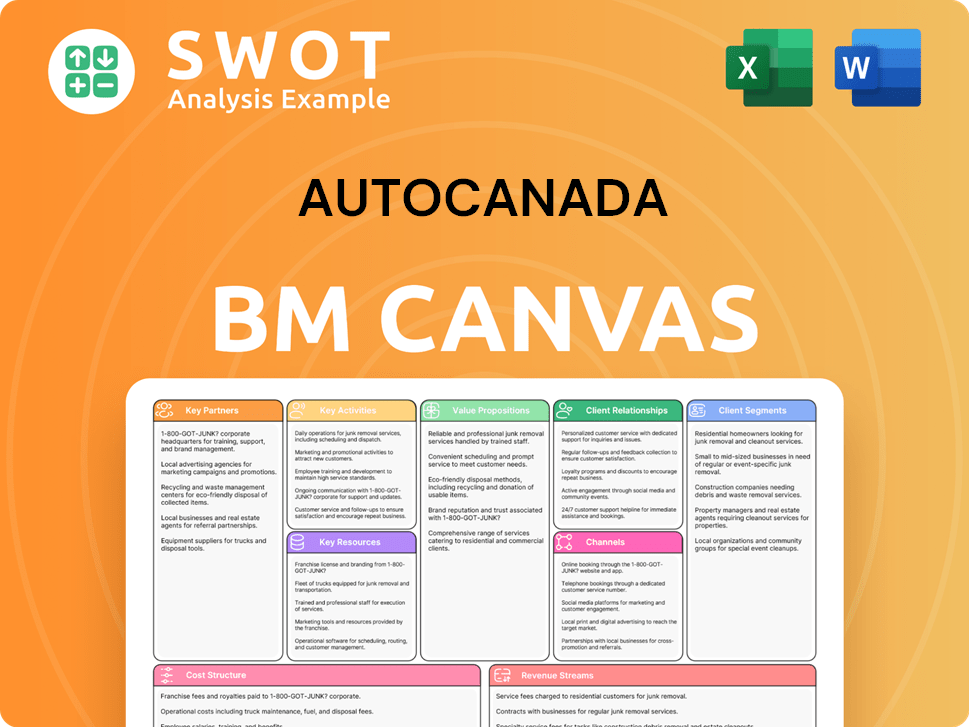AutoCanada Bundle
How is AutoCanada Driving Growth in the Automotive Industry?
AutoCanada's recent acquisition of Markville Toyota signals a bold move in its ongoing quest to dominate the Canadian automotive retail market. Founded in 1999, the company has evolved from a regional player to a national leader, showcasing a remarkable ability to adapt and expand. This strategic expansion highlights AutoCanada's commitment to consolidating its position through a diversified network of dealerships.

This analysis will explore AutoCanada's AutoCanada SWOT Analysis, delving into its strategic initiatives for future growth, including its expansion plans and how it aims to navigate the competitive landscape of the automotive industry. We'll examine its financial performance, including revenue growth and profitability analysis, and assess the potential impact of its electric vehicle strategy. Understanding AutoCanada's growth strategy is crucial for investors and industry watchers alike, as it shapes the future outlook of one of Canada's largest car dealerships.
How Is AutoCanada Expanding Its Reach?
AutoCanada's growth strategy centers on strategic expansion, primarily through increasing its dealership footprint and market penetration. The company actively pursues mergers and acquisitions, targeting high-performing dealerships across Canada and the United States. This approach allows AutoCanada to access new customer bases and reduce reliance on a single market, contributing to its overall revenue diversification.
The company's focus extends beyond acquisitions, emphasizing operational efficiencies and exploring new business models. This includes optimizing the existing portfolio and leveraging its scale to improve profitability across its dealerships. AutoCanada's expansion into the U.S. market, especially in states like Illinois, is a key pillar of its long-term strategy, providing significant inorganic growth opportunities.
AutoCanada's disciplined acquisition strategy focuses on dealerships that align with its operational strengths and offer strong financial returns. This approach is crucial for staying ahead of industry changes and maintaining a competitive edge. For more insights into the company's financial structure, consider reading about the Revenue Streams & Business Model of AutoCanada.
In Q1 2024, AutoCanada completed the acquisition of Markville Toyota. This high-volume dealership is located in a strategic market, enhancing AutoCanada's presence. The acquisition is part of the company's broader strategy to expand its dealership network and boost market share within Canada.
AutoCanada expanded into the U.S. market by acquiring a dealership in Illinois. This move is part of the company's long-term growth strategy, focusing on inorganic growth. Geographic diversification reduces reliance on a single market and opens up new customer bases for the company.
AutoCanada is focused on improving operational efficiencies across its dealerships. This includes leveraging scale to enhance profitability and streamlining operations. The goal is to optimize the existing portfolio and drive better financial performance.
The company's strategic initiatives include a disciplined acquisition strategy. This focuses on dealerships that align with AutoCanada's operational strengths. These initiatives contribute to revenue diversification and help the company stay ahead of industry changes.
AutoCanada's expansion strategy is multifaceted, involving both acquisitions and operational improvements. The company is focused on growing its dealership network and increasing market penetration. This involves strategic acquisitions and enhancing operational efficiencies.
- Strategic Acquisitions: Focusing on high-performing dealerships in Canada and the U.S.
- Geographic Diversification: Expanding into new markets to reduce reliance on a single region.
- Operational Efficiency: Leveraging scale to improve profitability across all dealerships.
- Disciplined Approach: Targeting dealerships that align with operational strengths and financial goals.
AutoCanada SWOT Analysis
- Complete SWOT Breakdown
- Fully Customizable
- Editable in Excel & Word
- Professional Formatting
- Investor-Ready Format

How Does AutoCanada Invest in Innovation?
The company is strategically leveraging technology and innovation to fuel sustained growth. This approach includes significant investments in digital transformation to streamline sales and service processes. The goal is to improve customer experience and optimize inventory management, reflecting a commitment to modernizing operations within the automotive industry.
The company is enhancing its online presence and e-commerce capabilities. This shift recognizes the growing importance of digital channels in vehicle sales and service. This strategy aims to meet evolving customer expectations and improve accessibility to its offerings, ensuring the company remains competitive in the evolving market.
The company's focus on integrating digital tools across its dealerships suggests an ongoing evaluation and adoption of technologies. This includes potential applications of AI for personalized customer interactions and IoT for vehicle diagnostics. These efforts aim to maintain a competitive edge and contribute to its growth objectives by improving efficiency and customer engagement.
The company is investing in digital transformation to streamline sales and service processes. This includes enhancing the online presence and e-commerce capabilities. These initiatives aim to improve customer experience and optimize inventory management.
Recognizing the growing importance of digital channels, the company is focusing on its online presence. This includes strategies to meet evolving customer expectations. The goal is to improve accessibility to its offerings.
The company is evaluating and adopting technologies to maintain a competitive edge. This includes potential applications of AI for personalized customer interactions. IoT for vehicle diagnostics is also being considered.
The strategic direction suggests an ongoing evaluation and adoption of technologies. This approach aims to contribute to its growth objectives. The company is focused on improving efficiency and customer engagement.
The company is committed to improving customer experience through digital initiatives. This includes streamlining sales and service processes. The goal is to meet the evolving needs of customers.
Optimizing inventory management is a key focus of the company's digital transformation. This includes leveraging technology to improve efficiency. The goal is to enhance overall operational performance.
The automotive industry is experiencing significant technological advancements. This includes the increased adoption of AI, IoT, and sustainable practices. The company's strategic initiatives suggest an ongoing evaluation of these technologies. This is aimed at enhancing its Brief History of AutoCanada, maintaining a competitive edge, and driving future growth.
The company's technology strategy emphasizes digital transformation and e-commerce. It focuses on enhancing customer experience and operational efficiency. The adoption of AI, IoT, and sustainable practices is also being considered.
- Digital Transformation: Streamlining sales and service processes.
- E-commerce: Enhancing online presence and sales capabilities.
- AI and IoT: Exploring applications for customer interactions and vehicle diagnostics.
- Sustainability: Considering sustainable practices within operations.
- Customer Experience: Improving accessibility and meeting evolving customer needs.
AutoCanada PESTLE Analysis
- Covers All 6 PESTLE Categories
- No Research Needed – Save Hours of Work
- Built by Experts, Trusted by Consultants
- Instant Download, Ready to Use
- 100% Editable, Fully Customizable

What Is AutoCanada’s Growth Forecast?
The financial outlook for AutoCanada appears robust, underpinned by strong performance in recent years. The company's strategic initiatives and disciplined financial management have positioned it well for continued expansion. Investors and stakeholders are closely watching the company's progress, particularly regarding its growth strategy and future prospects within the automotive industry.
AutoCanada has demonstrated a strong financial performance, with positive indicators for future growth. The company's focus on strategic acquisitions and operational efficiencies has contributed to its financial success. This has led to an increased interest in understanding the company's growth strategy and its potential impact on the automotive market.
The company's ability to generate strong cash flow and its prudent financial management provide a solid foundation for continued expansion and shareholder returns, underpinning its strategic plans for future growth. This financial stability is crucial for navigating the competitive landscape of AutoCanada and capitalizing on market opportunities.
In 2023, AutoCanada reported record revenue of $6.5 billion, marking a significant 19% increase compared to the previous year. This substantial revenue growth highlights the effectiveness of its acquisition-led expansion strategy and its ability to capture market share.
Adjusted EBITDA for 2023 also saw a significant rise to $342 million, up 17% from 2022. This improvement in profitability reflects the company's focus on operational efficiencies and its ability to integrate acquired dealerships successfully.
For Q1 2024, AutoCanada continued its positive momentum, reporting revenue of $1.5 billion, a 13% increase from Q1 2023. This sustained growth demonstrates the company's resilience and its ability to maintain its growth trajectory.
The company's net income for Q1 2024 was $32 million, reflecting a robust financial position. This solid net income underscores the company's profitability and its ability to generate strong returns.
AutoCanada’s financial ambitions are supported by its disciplined capital allocation strategy, focusing on profitable acquisitions and investments in its existing operations. The company's strong cash flow generation and prudent financial management provide a solid foundation for continued expansion and shareholder returns, underpinning its strategic plans for future growth.
The financial performance of AutoCanada is characterized by consistent revenue growth and improved profitability. The company's strategic initiatives, including acquisitions and operational efficiencies, have contributed to its strong financial results. Here are some key highlights:
- $6.5 Billion in revenue in 2023, a 19% increase.
- Adjusted EBITDA of $342 million in 2023, up 17%.
- Q1 2024 revenue of $1.5 billion, a 13% increase.
- Q1 2024 net income of $32 million.
AutoCanada Business Model Canvas
- Complete 9-Block Business Model Canvas
- Effortlessly Communicate Your Business Strategy
- Investor-Ready BMC Format
- 100% Editable and Customizable
- Clear and Structured Layout

What Risks Could Slow AutoCanada’s Growth?
Several risks and obstacles could affect the growth strategy of AutoCanada. The automotive industry is highly competitive. Economic downturns, fluctuating interest rates, and shifts in consumer spending habits could also impact the financial performance of the company.
Regulatory changes, particularly those related to environmental standards and vehicle emissions, might lead to higher costs or operational adjustments. Supply chain issues, like the recent semiconductor chip shortages, can disrupt vehicle availability, affecting sales volumes. The transition to electric vehicles (EVs) represents both an opportunity and a challenge, requiring significant investments.
The highly competitive nature of the car dealerships market, both in Canada and the U.S., poses a significant challenge. The company must navigate this landscape while also adapting to changing consumer preferences and economic conditions. Understanding the AutoCanada future outlook is crucial for investors.
The automotive retail sector is highly fragmented and competitive. Many car dealerships compete for market share. This intense competition can affect AutoCanada's ability to maintain or increase its profitability.
Economic downturns and interest rate increases can reduce consumer demand for vehicles. Changes in consumer spending habits, especially on big-ticket items like cars, can also impact sales. These factors can directly affect AutoCanada's revenue growth.
Regulatory changes, particularly those related to environmental standards and vehicle emissions, could impose additional costs. Compliance with new regulations may require significant investment and operational adjustments. These adjustments could affect AutoCanada's financial results.
Supply chain disruptions, such as semiconductor chip shortages, can limit vehicle availability. These shortages can directly impact sales volumes and revenue. Effective inventory management is crucial to mitigate these risks.
The shift to electric vehicles (EVs) presents both opportunities and risks. Significant investment is needed in charging infrastructure, technician training, and inventory management. AutoCanada's electric vehicle strategy will be key.
Operational challenges, including labor shortages and rising operational costs, can affect profitability. These issues require efficient management and strategic planning. AutoCanada's strategic initiatives must address these challenges.
To mitigate these risks, AutoCanada employs several strategies, including diversification across brands and geographies, disciplined inventory management, and a focus on operational efficiencies. The company's ability to adapt and learn from past disruptions, such as the pandemic-induced challenges, demonstrates its resilience. For further insight into the company's core values, mission, and vision, explore Mission, Vision & Core Values of AutoCanada.
Analyzing AutoCanada's financial results is crucial for understanding its ability to overcome challenges. Reviewing revenue growth, profitability analysis, and AutoCanada stock price forecast provides a clear picture. These metrics help assess the company's resilience and future potential.
AutoCanada's strategic initiatives, including acquisition strategy and new dealership openings, are vital. These moves can help the company expand its market share and improve its competitive position. Understanding these initiatives is key to assessing future prospects.
A thorough market analysis, including the competitive landscape and AutoCanada market share analysis, is essential. Understanding the dynamics of the automotive industry and the challenges faced by car dealerships is crucial. This analysis helps in identifying potential risks and opportunities.
Focusing on operational efficiencies is critical for AutoCanada's success. This includes optimizing online sales strategy and managing inventory effectively. Efficient operations can help the company navigate economic uncertainties and maintain profitability.
AutoCanada Porter's Five Forces Analysis
- Covers All 5 Competitive Forces in Detail
- Structured for Consultants, Students, and Founders
- 100% Editable in Microsoft Word & Excel
- Instant Digital Download – Use Immediately
- Compatible with Mac & PC – Fully Unlocked

Related Blogs
- What are Mission Vision & Core Values of AutoCanada Company?
- What is Competitive Landscape of AutoCanada Company?
- How Does AutoCanada Company Work?
- What is Sales and Marketing Strategy of AutoCanada Company?
- What is Brief History of AutoCanada Company?
- Who Owns AutoCanada Company?
- What is Customer Demographics and Target Market of AutoCanada Company?
Disclaimer
All information, articles, and product details provided on this website are for general informational and educational purposes only. We do not claim any ownership over, nor do we intend to infringe upon, any trademarks, copyrights, logos, brand names, or other intellectual property mentioned or depicted on this site. Such intellectual property remains the property of its respective owners, and any references here are made solely for identification or informational purposes, without implying any affiliation, endorsement, or partnership.
We make no representations or warranties, express or implied, regarding the accuracy, completeness, or suitability of any content or products presented. Nothing on this website should be construed as legal, tax, investment, financial, medical, or other professional advice. In addition, no part of this site—including articles or product references—constitutes a solicitation, recommendation, endorsement, advertisement, or offer to buy or sell any securities, franchises, or other financial instruments, particularly in jurisdictions where such activity would be unlawful.
All content is of a general nature and may not address the specific circumstances of any individual or entity. It is not a substitute for professional advice or services. Any actions you take based on the information provided here are strictly at your own risk. You accept full responsibility for any decisions or outcomes arising from your use of this website and agree to release us from any liability in connection with your use of, or reliance upon, the content or products found herein.